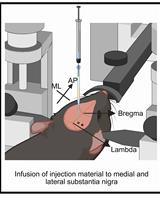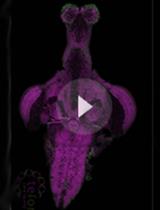- EN - English
- CN - 中文
Various Modes of Spinal Cord Injury to Study Regeneration in Adult Zebrafish
采用各种脊髓损伤模型研究成年斑马鱼中的细胞再生
发布: 2016年12月05日第6卷第23期 DOI: 10.21769/BioProtoc.2043 浏览次数: 13227
评审: Oneil G. BhalalaJingli CaoHélène M. Léger

相关实验方案

基于 rAAV-α-Syn 与 α-Syn 预成纤维共同构建的帕金森病一体化小鼠模型
Santhosh Kumar Subramanya [...] Poonam Thakur
2025年12月05日 1185 阅读
Abstract
Spinal cord injury (SCI) in mammals leads to failure of both sensory and motor functions, due to lack of axonal regrowth below the level of injury as well as inability to replace lost neural cells and to stimulate neurogenesis. In contrast, fish and amphibians are capable of regenerating a variety of their organs like limb/fin, jaw, heart and various parts of the central nervous system (CNS). Zebrafish embryo and adult has become a very popular model to study developmental biology, cell biology and regeneration for various reasons. Adult zebrafish, one of the most important vertebrate models to study regeneration, can regenerate many of their body parts like fin, jaw, heart and CNS. In the present article we provide information on how to inflict different injury modalities in adult fish spinal cord. Presently, the significant focus of mammalian SCI is to use crush and contusion injury. To generate an entity comparable to the mammalian mode of injury, we have introduced the crush model in adult zebrafish along with complete transection injury, which is also known to be a valuable model to study axonal regeneration. Here we provide full description of the highly reproducible surgical procedures including some representative results. This protocol has been adapted from our previous publications, viz. Hui et al., 2010 and Hui et al., 2014. Briefly, we have described the two different injury modalities, crush and complete transection, and demonstrated the outcome of inflicting these injuries in the adult zebrafish cord by histological analysis of the tissues.
Keywords: Spinal cord (脊髓)Background
Any injury to mammalian spinal cord leads to the devastating consequence of paralysis and loss of function. In contrast to mammals, injury response in zebrafish cord is quite different, resulting in repair and regeneration of cord followed by functional recovery. A variety of lesioning protocols have been employed to study spinal cord injury and functional recovery in lower vertebrates (Holtzer 1956; Egar and Singer, 1972; Filoni et al., 1984; Becker et al., 1997; Margotta et al., 1991; Hui et al., 2010; Sîrbulescu and Zupanc, 2011) in last five decades. Among them the most popular experimental protocol to study spinal cord regeneration has been tail amputation (Holtzer, 1956; Egar and Singer, 1972; Filoni et al., 1984; Margotta et al., 1991; Sîrbulescu and Zupanc, 2011). Tail amputation involves complete removal of the caudal part of tail, where muscle, skin, bone and cartilages are also removed along with spinal cord. There is complete regeneration of tail along with the spinal cord leading to functional recovery after tail amputation and a substantial progress has been made to understand the cellular mechanism of spinal cord regeneration. But there are drawbacks of using this model. The major criticism against this model is that, it does not appropriately mimic SCI in human, since there is no tail structure in humans and the nature of the injury is different.
In teleosts, the most important lesion paradigm that has been widely used to study spinal cord regeneration is complete transection (Becker et al., 1997; Goldshmit et al., 2012). Transection refers to complete severing of cord which can often lead to spinal shock in humans. It occurs rarely in comparison to hemisection which commonly occurs in gunshot wounds. Transection could be the appropriate model to study axonal regeneration since there is no axonal sparing after transection injury and some believe that axonal sparing itself could augment regeneration in mammals (Basso et al., 1996).
On the other hand, compression and crush injuries are most prevalent in mammals under experimental conditions and in human accidental injury conditions (Thuret et al., 2006). In search for an appropriate injury model to study the regeneration in teleost, we successfully established a standardized crush injury model in zebrafish, which is comparable to the mammalian mode of injury (Hui et al., 2010). Among all the experimental paradigms mentioned, standardized crush injury is the most suitable model to understand both the mammalian and the teleostean scenario compared to transection or tail amputation models. The outcome of crush injury varies when compared to transection injury, as in crush injury secondary degenerative response elicits axonal degeneration, whereas in transection injury axonal tracts are disengaged almost immediately after injury.
Materials and Reagents
- Pyrex Glass Petri dishes (150 x 20 mm) (Corning, catalog number: 3160-152BO )
- Pyrex crystallizing dish (Corning, catalog number: 3140-150 )
- Wheaton Coplin staining jars (Sigma-Aldrich, catalog number: S6016 )
- Moist tissue paper
- Needle
- Single edged surgical blade (Sigma-Aldrich, catalog number: S2771 )
- Cotton swabs, sterile (6 inch) (Medline Industries, catalog number: MDS202000Z )
- Plastic Pasteur pipettes (BRAND, catalog number: 747755 )
- Phosphate buffered saline (PBS), pH 7.4 (Sigma-Aldrich, catalog number: P4417 )
- Tricaine (MS222) (Sigma-Aldrich, catalog number: E10521 )
- Zebrafish Aquarium System water
- 0.1% cresyl violet solution (Sigma-Aldrich, catalog number: C5042 )
- 0.1% luxol fast blue solution (Sigma-Aldrich, catalog number: L0294 )
- 4% paraformaldehyde (Sigma-Aldrich, catalog number: 158127 )
- 0.5 M EDTA (Sigma-Aldrich, catalog number: E9884 )
- Paraffin (Sigma-Aldrich, catalog number: 327212 )
- Xylene (Sigma-Aldrich, catalog number: 534056 )
- 0.05% lithium carbonate solution (Sigma-Aldrich, catalog number: 255823 )
- Graded ethanol (Sigma-Aldrich, catalog number: 24102 )
Note: This product has been discontinued. - Glacial acetic acid (Sigma-Aldrich, catalog number: A6283 )
Equipment
- Leica rotary microtome (Leica Biosystems Nussloch, model: RM 2125RTS )
- Student Dumont #5 forceps (Sigma-Aldrich, catalog number: F6521 )
- Micro dissectingspring scissors (Harvard Apparatus, catalog number: 728500 )
- Stereozoom dissecting microscope (Olympus, models: SZX7 and SZ51 )
Procedure
文章信息
版权信息
© 2016 The Authors; exclusive licensee Bio-protocol LLC.
如何引用
Readers should cite both the Bio-protocol article and the original research article where this protocol was used:
- Hui, S. P. and Ghosh, S. (2016). Various Modes of Spinal Cord Injury to Study Regeneration in Adult Zebrafish. Bio-protocol 6(23): e2043. DOI: 10.21769/BioProtoc.2043.
- Hui, S. P., Sengupta, D., Lee, S. G., Sen, T., Kundu, S., Mathavan, S. and Ghosh, S. (2014). Genome wide expression profiling during spinal cord regeneration identifies comprehensive cellular responses in zebrafish. PLoS One 9(1): e84212.
分类
神经科学 > 神经系统疾病 > 动物模型
细胞生物学 > 组织分析 > 组织染色
您对这篇实验方法有问题吗?
在此处发布您的问题,我们将邀请本文作者来回答。同时,我们会将您的问题发布到Bio-protocol Exchange,以便寻求社区成员的帮助。
提问指南
+ 问题描述
写下详细的问题描述,包括所有有助于他人回答您问题的信息(例如实验过程、条件和相关图像等)。
Share
Bluesky
X
Copy link












